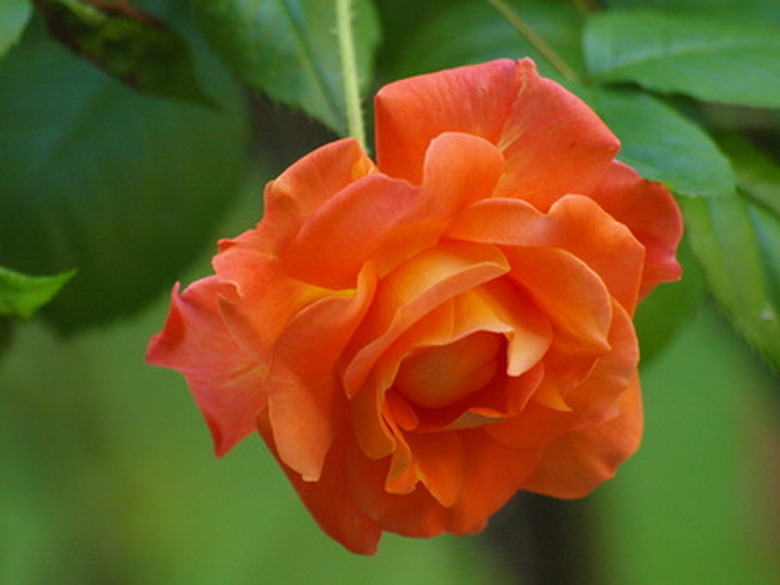How To Care For A Joseph's Coat Climbing Rose
We may receive a commission on purchases made from links.
Rosa 'Joseph's Coat' explodes in multicolored brilliance with a kaleidoscopic effect of bright red, coral and gold tones, often appearing to change colors. A perennial in U.S. Department of Agriculture plant hardiness zones 5 to 9, this climbing rose blooms from late spring to fall with moderately fragrant, 3- to 4-inch-wide flowers growing on both old and new wood. Mature plants can grow 8 to 12 feet high and 4 to 6 feet wide with stiff, prickly stems and deep-green leaves for contrast against the vivid blooms. Proper care for the Joseph's Coat climbing rose includes lots of sun and consistent watering.
Ideal Growing Conditions
Ideal Growing Conditions
A Joseph's Coat climbing rose prefers full sun, but it can also grow in partial shade. Choose a spot with rich, fertile soil that drains well. Amend the soil with compost if needed to make it nutrient-dense and easy to work. These climbing roses also prefer the soil to be slightly acidic, although they tolerate a range of soil pH levels. You can check the acidity with a soil tester.
Since Joseph's Coat is a climbing rose, it needs a spot with a structure for support. These roses can grow along walls and fences. They also do well on arbors, pergolas and trellises. The roses naturally grow in an upright pattern, but the flexible canes allow you to train the roses as needed or desired.
Planting Joseph's Coat Climbing Roses
Planting Joseph's Coat Climbing Roses
Work the soil to loosen it and add amendments as needed. When planting multiple roses, leave about 4 to 6 feet between the plants to allow for the mature size. Position the plant with the bud union just at or slightly above the soil's surface.
Dig a hole that's twice the width of the root ball and about the same depth. Spread the roots out evenly in the hole you prepare. Fill the hole halfway and press down the soil. Fill with the remaining soil and compact it again. Water the newly planted rose well.
Watering and Fertilizing the Roses
Watering and Fertilizing the Roses
Your Joseph's Coat climbing rose needs about 1 inch of water each week to keep the soil moist without being overly saturated. Use a rain gauge to monitor the natural moisture it gets. Supplement as needed to keep the rose properly watered. Check the soil regularly to see if it feels dry. When the soil is dry to 3 inches, it's time to irrigate the roses.
This type of climbing rose benefits from regular fertilizer for additional nutrients. Ideally, you should perform a soil test to determine soil fertility and the need for any nutrients. In the absence of a soil test, use fertilizer formulated for roses to ensure your plant gets the correct nutrients. Slow-release formulas often need to be applied only every two to three months. Ideal times for fertilizer applications are one time in the spring when new growth starts and one time in the summer.
Pruning Joseph's Coat Climbing Roses
Pruning Joseph's Coat Climbing Roses
Pruning roses is a common part of the care routine. Joseph's Coat climbing roses don't need a lot of pruning other than to shape the plant as desired. Clip off the spent blooms with sharp, sanitized pruning shears to encourage continued blooming and to clean up the look of the plant. Prune the suckers and weak stems to keep the climbing rose strong and healthy.
Winter Rose Care
Winter Rose Care
Your Joseph's Coat climbing rose is tolerant of extreme temperatures, but it does well with a little extra care to weather the colder winter months. Mulch the base of the rose heavily in preparation for winter. You can cover additional parts of the plant with straw for additional cold protection.
